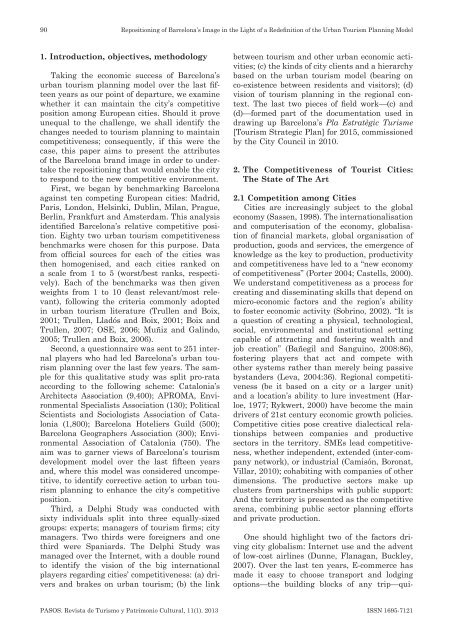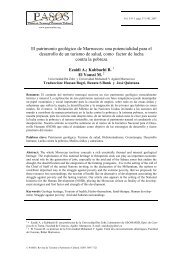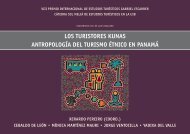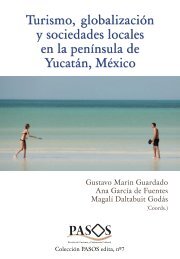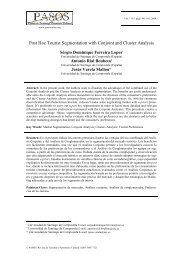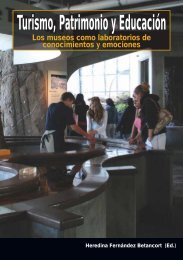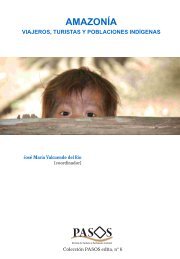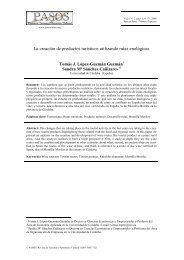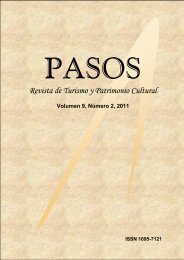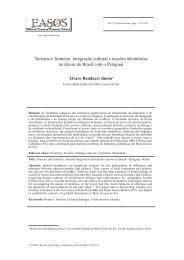Full Journal - Pasos
Full Journal - Pasos
Full Journal - Pasos
Create successful ePaper yourself
Turn your PDF publications into a flip-book with our unique Google optimized e-Paper software.
90 Repositioning of Barcelona’s Image in the Light of a Redefinition of the Urban Tourism Planning Model<br />
1. Introduction, objectives, methodology<br />
Taking the economic success of Barcelona’s<br />
urban tourism planning model over the last fifteen<br />
years as our point of departure, we examine<br />
whether it can maintain the city’s competitive<br />
position among European cities. Should it prove<br />
unequal to the challenge, we shall identify the<br />
changes needed to tourism planning to maintain<br />
competitiveness; consequently, if this were the<br />
case, this paper aims to present the attributes<br />
of the Barcelona brand image in order to undertake<br />
the repositioning that would enable the city<br />
to respond to the new competitive environment.<br />
First, we began by benchmarking Barcelona<br />
against ten competing European cities: Madrid,<br />
Paris, London, Helsinki, Dublin, Milan, Prague,<br />
Berlin, Frankfurt and Amsterdam. This analysis<br />
identified Barcelona’s relative competitive position.<br />
Eighty two urban tourism competitiveness<br />
benchmarks were chosen for this purpose. Data<br />
from official sources for each of the cities was<br />
then homogenised, and each cities ranked on<br />
a scale from 1 to 5 (worst/best ranks, respectively).<br />
Each of the benchmarks was then given<br />
weights from 1 to 10 (least relevant/most relevant),<br />
following the criteria commonly adopted<br />
in urban tourism literature (Trullen and Boix,<br />
2001; Trullen, Lladós and Boix, 2001; Boix and<br />
Trullen, 2007; OSE, 2006; Muñiz and Galindo,<br />
2005; Trullen and Boix, 2006).<br />
Second, a questionnaire was sent to 251 internal<br />
players who had led Barcelona’s urban tourism<br />
planning over the last few years. The sample<br />
for this qualitative study was split pro-rata<br />
according to the following scheme: Catalonia’s<br />
Architects Association (9,400); APROMA, Environmental<br />
Specialists Association (130); Political<br />
Scientists and Sociologists Association of Catalonia<br />
(1,800); Barcelona Hoteliers Guild (500);<br />
Barcelona Geographers Association (300); Environmental<br />
Association of Catalonia (750). The<br />
aim was to garner views of Barcelona’s tourism<br />
development model over the last fifteen years<br />
and, where this model was considered uncompetitive,<br />
to identify corrective action to urban tourism<br />
planning to enhance the city’s competitive<br />
position.<br />
Third, a Delphi Study was conducted with<br />
sixty individuals split into three equally-sized<br />
groups: experts; managers of tourism firms; city<br />
managers. Two thirds were foreigners and one<br />
third were Spaniards. The Delphi Study was<br />
managed over the Internet, with a double round<br />
to identify the vision of the big international<br />
players regarding cities’ competitiveness: (a) drivers<br />
and brakes on urban tourism; (b) the link<br />
between tourism and other urban economic activities;<br />
(c) the kinds of city clients and a hierarchy<br />
based on the urban tourism model (bearing on<br />
co-existence between residents and visitors); (d)<br />
vision of tourism planning in the regional context.<br />
The last two pieces of field work—(c) and<br />
(d)—formed part of the documentation used in<br />
drawing up Barcelona’s Pla Estratègic Turisme<br />
[Tourism Strategic Plan] for 2015, commissioned<br />
by the City Council in 2010.<br />
2. The Competitiveness of Tourist Cities:<br />
The State of The Art<br />
2.1 Competition among Cities<br />
Cities are increasingly subject to the global<br />
economy (Sassen, 1998). The internationalisation<br />
and computerisation of the economy, globalisation<br />
of financial markets, global organisation of<br />
production, goods and services, the emergence of<br />
knowledge as the key to production, productivity<br />
and competitiveness have led to a “new economy<br />
of competitiveness” (Porter 2004; Castells, 2000).<br />
We understand competitiveness as a process for<br />
creating and disseminating skills that depend on<br />
micro-economic factors and the region’s ability<br />
to foster economic activity (Sobrino, 2002). “It is<br />
a question of creating a physical, technological,<br />
social, environmental and institutional setting<br />
capable of attracting and fostering wealth and<br />
job creation” (Bañegil and Sanguino, 2008:86),<br />
fostering players that act and compete with<br />
other systems rather than merely being passive<br />
bystanders (Leva, 2004:36). Regional competitiveness<br />
(be it based on a city or a larger unit)<br />
and a location’s ability to lure investment (Harloe,<br />
1977; Rykwert, 2000) have become the main<br />
drivers of 21st century economic growth policies.<br />
Competitive cities pose creative dialectical relationships<br />
between companies and productive<br />
sectors in the territory. SMEs lead competitiveness,<br />
whether independent, extended (inter-company<br />
network), or industrial (Camisón, Boronat,<br />
Villar, 2010); cohabiting with companies of other<br />
dimensions. The productive sectors make up<br />
clusters from partnerships with public support:<br />
And the territory is presented as the competitive<br />
arena, combining public sector planning efforts<br />
and private production.<br />
One should highlight two of the factors driving<br />
city globalism: Internet use and the advent<br />
of low-cost airlines (Dunne, Flanagan, Buckley,<br />
2007). Over the last ten years, E-commerce has<br />
made it easy to choose transport and lodging<br />
options—the building blocks of any trip—qui-<br />
PASOS. Revista de Turismo y Patrimonio Cultural, 11(1). 2013 ISSN 1695-7121


